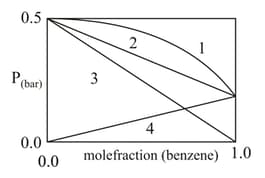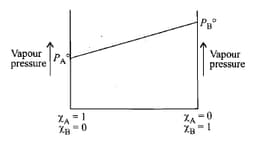Raoult's Law
Raoult's Law: Overview
This topic covers concepts, such as, Raoult's Law, Raoult's Law for an Ideal Solution of Two Liquid Components, Rault's Law as a Special Case of Henry's Law & Vapour Pressure of Solutions of Solids in Liquids etc.
Important Questions on Raoult's Law
An aqueous solution is made by dissolving of glucose in of water at . If the vapour pressure of pure water at is , what would be the vapour pressure of the solution?
What changes occurs in the vapour pressure as a non-volatile solute is added to a pure liquid solvent?
Two liquids are mixed together to form a mixture which boils at same temperature and their boiling point is higher than the boiling point of either of them, so they show _____ from Raoult's law.
The vapour pressure of the solution is affected by adding the _____ solute.
When will the vapour pressure of the volatile liquid lowered?
The vapour pressure of water is at . Now, calculate the vapour pressure of molar solution of a solute in it.
How we can prove that Raoult’s law as a special case of Henry’s law?
Raoult's law becomes a special case of Henry's law when . In this equation, is
Raoult's law becomes a special case of Henry's law when becomes equal to _____.
"Enter the correct answer as or ."
Condition at which Raoult's law becomes a special case of Henry's law?
Raoult's law becomes a special case of Henry's law when becomes equal to .
A mixture of toluene and benzene forms a nearly ideal solution. Assume and to be the vapor pressures of pure benzene and toluene, respectively. The slope of the line obtained by plotting the total vapor pressure to the mole fraction of benzene is:
In the pressure vs. the mole fraction of benzene curves/lines shown below, the total vapour pressure of an ideal mixture of benzene and toluene will follow the curve/line.

Vapour pressure of benzene is . When of non-volatile solute is dissolved in benzene, benzene solution has vapour pressure . Calculate the molar mass of the solute in ( molar mass of benzene = ).
Raoult's law states that for a solution of volatile liquids, the partial vapour pressure of each component of the solution is directly proportional to its mole fraction present in solution.
_____ law which states that for a solution of volatile liquids, the partial vapour pressure of each component of the solution is directly proportional to its mole fraction present in solution.
The following is a graph plotted between the vapour pressure of two volatile liquids against their respective mole fractions.

Which of the following statement is correct ?
For a dilute solution containing of a non-volatile non-electrolyte solution in of water, the elevation in boiling point at pressure is Assuming the concentration of solute is much lower than the concentration of the solvent, the vapor pressure of the solution is ()
Two liquids and form an ideal solution. At , vapour pressure of the solution containing mole of and mole of is . At the same temperature, if mole of is further added to this solution, vapour pressure of the solution increases by . Vapour pressure (in ) of and in their pure states will be, respectively
The vapours pressure of pure components and are and respectively. Assuming a solution of these components obeys Raoult's law, the mole fraction of component in the vapours phase in equilibrium with a solution containing equimolecular of and is
